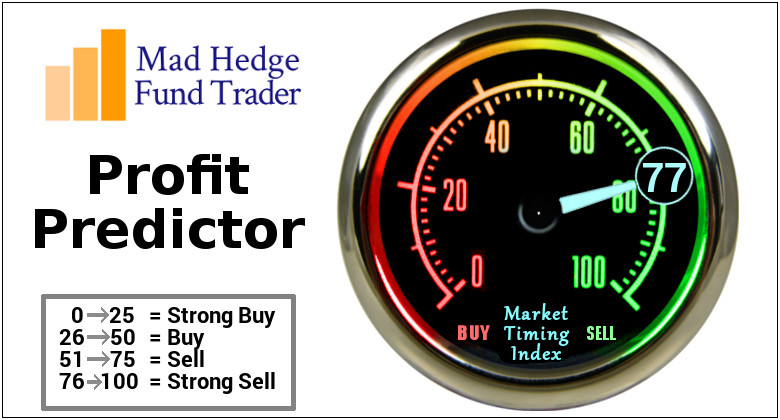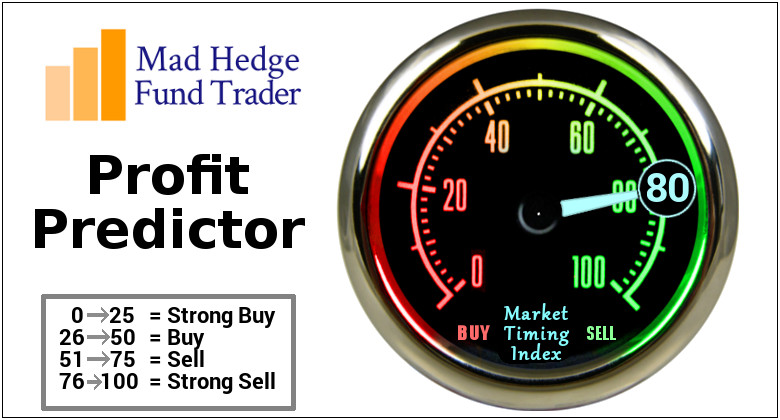While the Diary of a Mad Hedge Fund Trader focuses on investment over a one week to a six-month time frame, Mad Day Trader, provided by Bill Davis, will exploit money-making opportunities over a brief ten minute to three-day window. It is ideally suited for day traders, but can also be used by long-term investors to improve market timing for entry and exit points. Read more
Global Market Comments
December 11, 2020
Fiat Lux
FEATURED TRADE:
(DECEMBER 9 BIWEEKLY STRATEGY WEBINAR Q&A),
(GLD), (FXA), (FXE), (FXC), (UUP), (FXB), (ABNB), (DASH), (TAN), (TLT), (TBT), (NZD), (DKNG), (SNOW), (AAPL), (CRSP), (RTX), (NOC)
Below please find subscribers’ Q&A for the December 9 Mad Hedge Fund Trader Global Strategy Webinar broadcast from Incline Village, NV with my guest and co-host Bill Davis.
Q: Is gold (GLD) about ready to turn around from here?
A: The gold bottom will be easy to call, and that’s when the Bitcoin top happens. In fact, we have a double top risk going on in Bitcoin right now, and we had a little bit of a rally in gold this week as a result. So, longer term you need actual inflation to show up to get gold any higher, and we may actually get that in a year or two.
Q: The US dollar (UUP) has been weak against most currencies including the Canadian dollar (FXC), but Canada has the same problems as the US, but worse regarding debt and so on. So why is the Canadian dollar going up against the US dollar?
A: Because it’s not the US dollar. Canada also has an additional problem in that they export 3.7 million barrels a day of oil to the US and the dollar value have been in freefall this year. Canada has the most expensive oil in the world. So, taking that out of the picture, the Canadian dollar still would be negative, and for that reason I've been recommending the Australian dollar (FXA) as my first foreign currency pick, looking for 1:1 over the next three years. Of the batch, the Canadian dollar is probably going to be the weakest, Australian dollar the strongest, and the Euro (FXE) somewhere in the middle. I don’t want to touch the British pound (FXB) as long as this Brexit mess is going on.
Q: Would you buy the IPO’s Airbnb (ABNB) and Dash (DASH)?
A: No on Dash. The entries to new competitors are low. Airbnb on the other hand is now the largest hotel in the world, and it just depends on what price it comes out at. If it comes out at a stupid price, like 50% over the IPO, I wouldn’t bother; but if you can get close to the IPO price, I would probably buy it for the long term. I think you would have another double if we got close to the IPO price, so that is worth doing. They have been absolutely brilliant in their management and the way they handled the pandemic; they basically captured all the hotel business because if you rent an apartment all by yourself, the COVID risk is much lower than if you go into a Hilton or another hotel. They also made a big push on local travel which was successful. They gave up long-distance travel, and they’re now trying to get you to explore your own area; and that worked beyond all expectations. Even I have rented some Airbnb’s out in the local area like in Carmel, Monterey, Mendocino, and so on and I came back disease-free.
Q: If the United States Treasury Bond Fund (TLT) goes to a 1.00% yield, what would that translate to in the (TBT) (2x short treasury ETF)?
A: My guess is probably about $18, which has been upside resistance for a long time, but it depends on how long it takes to get there. You have about a 3% a year cost of carry on the TBT that you don’t have in Treasuries.
Q: Should we buy China stocks when the current administration is so negative on China?
A: Yes, that’s when you buy them—when the current administration is negative on China; because when you get an administration that’s less negative on China, the Chinese stocks will all rocket. There’s an easy 20-30% in most of the headline Chinese stocks from here sometime in 2021. And I'm looking to add more Chinese stocks. I currently have Alibaba (BABA), and that’s working well. I want to pick up some more.
Q: What about the New Zealand currency ETF (NZD)?
A: It pretty much moves in sync with the Australian dollar, but it’s usually a few cents cheaper and more volatile.
Q: Legalized sports betting seems to be on the upswing. Where do you see DraftKings (DKNG) going?
A: I think it goes up. I think there’s going to be a recovery in all kinds of entertainment type activities. Draft Kings got a huge market share from the pandemic which they will probably keep.
Q: Do we use spreads when playing (FXA)?
A: Yes, you can probably do something like a $70-$72 here one month out and make some decent money.
Q: How do you feel about Snowflake (SNOW)?
A: I wanted to get into this from day one, but it doubled on the IPO, and then it doubled again. It’s one of the only technology stocks Warren Buffet has bought in the last several years besides Apple (AAPL). So, it’s just too popular right now, it’s hotter than hot. They have a dominant market share in their big data platform, so it’s a great place to be but it’s really expensive now.
Q: Do your options trade alerts have any risk of assignment?
A: Yes, they do, but when you get an assignment it’s a gift, because they’re taking you out of your maximum profit point, weeks before the expiration. All you do is tell your broker to use your long position to cover your short position, and you will get the 100% profit right then and there. I say this because the brokers always tell you to do the wrong thing when you get an assignment, such as going into the market to close out each leg separately. That is a huge mistake, and only makes money for the brokers. For more details, log in and search for “assignments” at www.madhedgefundtrader.com
Q: Congratulations on your great performance; what could derail your bullish prediction?
A: Well, we’ve already had a pandemic so obviously that’s not it, and then you have to run by your usual reasons for an out-of-the-blue crash; let’s say Donald Trump doesn't leave the presidency. That would be worth a few thousand points of downside. So would a major war. We could have both; we could have a major war before a disrupted inauguration. The president has essentially unlimited ability to go to war at any time, so there aren’t too many negatives on the near-term horizon, which is why everyone is super bullish.
Q: What’s your opinion on the solar area, stocks like First Solar (FSLR) and the Invesco Solar ETF (TAN)?
A: I’m bullish. Even though they're over 300% since March, we’re about to enter the golden age of solar. Biden wants to install 500,000 solar panels next year and provide the subsidies to accomplish that. This all looks extremely positive for solar. In California, a lot of people will go solar, because getting an independent power supply protects you from the power shut-offs that happen every time the wind picks up, in which response to wildfire danger. We had ten days of statewide power blackouts this year.
Q: What are your thoughts on lithium?
A: I’m not a big believer in lithium because there is no short supply. The key to producing lithium is finding countries with no environmental controls whatsoever because it’s a very polluting and messy process to mine. Better to let other countries mine your lithium cheap, refine it, and then send it to you in finished form.
Q: Since you love CRISPR (CRSP) at $130, what about shorting naked puts? The premiums are really high.
A: I never advocate shorting naked puts. Occasionally, I will at extreme market bottoms like we had in March, but even then, I do it only on a 1 for 1 basis, meaning don’t use any leverage or margin. Never short any more puts than you’re willing to buy the stock lower down. People regularly see the easy money, sell short too many puts, and then get a market correction and a total wipeout of their capital. And they won't have to do that liquidation themselves; their broker will do it for them. They’ll do a forced liquidation of your account and then close it because they don't want to be left holding the bag on any excess losses. You won’t find out until afterwards. So, I would not recommend shorting naked puts for the normal investor. If you want to be clever, just buy an in-the-money call spread, something like a $110-$120 out a couple of months. That's probably a far better risk reward than shorting a naked put. By the way, I came close to wiping out Solomon Brothers 30 years ago because my hedge fund was short too many Nikkei Puts. In the end, I made a fortune, but only after a few sleepless nights (remember that Mark?).
Q: What do you think about defense stock right now?
A: I’m avoiding defense stock because I don’t see any big increases in defense spending in the future administration, and that would include Raytheon (RTX), Northrop Grumman (NOC), and some of the other big defense stocks.
SEE YOU ALL IN 2021!
Good Luck and Stay Healthy.
John Thomas
CEO & Publisher
The Diary of a Mad Hedge Fund Trader
“Sometimes, when you jump off a bridge, you have to grow your wings on the way down,” said author Danielle Steele.
Mad Hedge Biotech & Healthcare Letter
December 10, 2020
Fiat Lux
FEATURED TRADE:
(A STOCK TO SWEETEN YOUR YEAR)
(NVO), (LLY), (MRK), (PFE)
Diabetes is one of the major health issues plaguing the United States, with the CDC reporting that over 34 million people are suffering from this disease – and 20% of them are not even aware of their condition.
More alarmingly, there are at least 88 million individuals that are already in the prediabetic stage.
Since the number of people with diabetes has multiplied in the past 20 years, it presents a massive market for a lot of biotechnology and healthcare companies.
In 2019, the diabetes treatment and drug sector in the US alone recorded a landmark valuation of more than $15 billion and the CDC expects this number to reach $16 billion by 2025.
That’s why it comes as no surprise that more and more companies are attempting to corner the diabetes market.
Since it was founded back in 1876, Eli Lilly (LLY) has been known as the king of the diabetes industry.
However, one competitor has been aggressively working to dethrone Eli Lilly: Novo Nordisk (NVO).
In 2019, NVO’s share in the global diabetes market reached an impressive 29%.
Now, the company aims to boost its share to reach more than 33% by 2025.
Looking at its track record, NVO’s goal of becoming one of the most dominant forces in the diabetes sector is very close to reality.
The company recorded consecutive revenue and net income increases for the past three years.
According to its second quarter report for 2020, NVO reported $4.8 million in revenue. Meanwhile, its net income reached $1.7 billion, representing an 11% boost compared to its performance in the same period last year.
NVO has also seen a promising growth from its newly launched Type 2 diabetes treatments, Ozempic and Rybelsus.
Ozempic alone has been phenomenal, with the drug already reporting $1.1 billion in sales for the first half of 2020 in the US.
This shows off an impressive 156% increase from its record during the same period in 2019 – and the drug has yet to reach its peak.
To put things in perspective, Ozempic recorded $1.7 billion in annual sales last year, a substantial jump from the $264 million it earned when it was launched in 2018.
Rybelsus is another drug expected to take in huge numbers for NVO. The drug has already brought in $64.5 million in revenue in the first six months since its launch in the fourth quarter of 2019.
While all these sound promising, NVO actually has another trick up its sleeve.
The company is planning to sustain its growth by catering to large and well-defined but underserved sectors.
Interestingly, this is similar to the strategy used by Merck (MRK) and Pfizer (PFE) from 1982 to 2000.
At the time, the two healthcare titans decided to cater to the then under-penetrated market of cardiovascular disease.
Initially, the goal was to provide treatments that can abate the risk factors of a heart disease called atherosclerosis. Merck and Pfizer isolated two issues they wanted to address: hypertension and high cholesterol.
Apart from eventually creating drugs specializing in these health issues, Pfizer went on to discover that an ingredient of its products has the sought-after side effect of letting men feel “young” and active once again.
Thus, the best selling Viagra was born.
From the way NVO has been handling its pipeline candidates, a similar result might be well on its way.
For instance, its moneymaker Ozempic is now considered a promising candidate for another underserved market: the progressive liver disease NASH.
Other than that, NVO is also working on listing obesity as a chronic disease. That way, insurers will be required to cover treatment for the condition.
To date, there are 650 million people categorized as obese and only 2% of them are seeking treatment.
Once again, Ozempic will be a stepping stone in this plan.
NVO has been testing the drug’s efficacy on diminishing the patient’s appetite, calling the experimental Ozempic application AM833.
This can gradually transform into a solid revenue source as there are roughly 460 million people suffering from diabetes worldwide, and only 6% of them are in control of their condition.
Basically, NVO is aiming to prevent complications derived from obesity and diabetes.
With such a distinct approach to the growing opportunities, NVO is undoubtedly on its way to building a mega-franchise.
Despite the COVID-19 pandemic wreaking havoc across the globe, NVO is one of the handful of companies with rising earnings expectations this year.
From the previous guidance of $2.72 earnings per share, the company increased it to $2.86 for the rest of the year. Even its 2021 forecast climbed from $3.05 EPS to $3.14.
Overall, this company offers a solid and sustainable revenue stream along with a promising pipeline of candidates with the potential to become mega-blockbusters well beyond the diabetes sector.

When John identifies a strategic exit point, he will send you an alert with specific trade information as to what security to sell, when to sell it, and at what price. Most often, it will be to TAKE PROFITS, but, on rare occasions, it will be to exercise a STOP LOSS at a predetermined price to adhere to strict risk management discipline. Read more
Today, I would like to make a suggestion on a covered call.
And the stock is Turtle Beach Corp. (HEAR).
HEAR is trading around $19.60 as I write this.
The December monthly calls expires in 6 days.
I am going to suggest you buy HEAR at the market, which is $19.60.
After you buy the stock, then sell the December $20 call.
Here is that part of the trade:
Sell to Open one December 18th-$20 call for $.65 for every 100 shares you buy.
If these calls are assigned next Friday, the return will be 5.4% for just over a week.
Based on the nominal portfolio, limit the stock buy in to 300 shares, or 5.9% of the tracking portfolio.
While the Diary of a Mad Hedge Fund Trader focuses on investment over a one week to a six-month time frame, Mad Day Trader, provided by Bill Davis, will exploit money-making opportunities over a brief ten minute to three-day window. It is ideally suited for day traders, but can also be used by long-term investors to improve market timing for entry and exit points. Read more
Global Market Comments
December 10, 2020
Fiat Lux
FEATURED TRADE:
(MY 20 RULES FOR TRADING IN 2021)
Legal Disclaimer
There is a very high degree of risk involved in trading. Past results are not indicative of future returns. MadHedgeFundTrader.com and all individuals affiliated with this site assume no responsibilities for your trading and investment results. The indicators, strategies, columns, articles and all other features are for educational purposes only and should not be construed as investment advice. Information for futures trading observations are obtained from sources believed to be reliable, but we do not warrant its completeness or accuracy, or warrant any results from the use of the information. Your use of the trading observations is entirely at your own risk and it is your sole responsibility to evaluate the accuracy, completeness and usefulness of the information. You must assess the risk of any trade with your broker and make your own independent decisions regarding any securities mentioned herein. Affiliates of MadHedgeFundTrader.com may have a position or effect transactions in the securities described herein (or options thereon) and/or otherwise employ trading strategies that may be consistent or inconsistent with the provided strategies.







